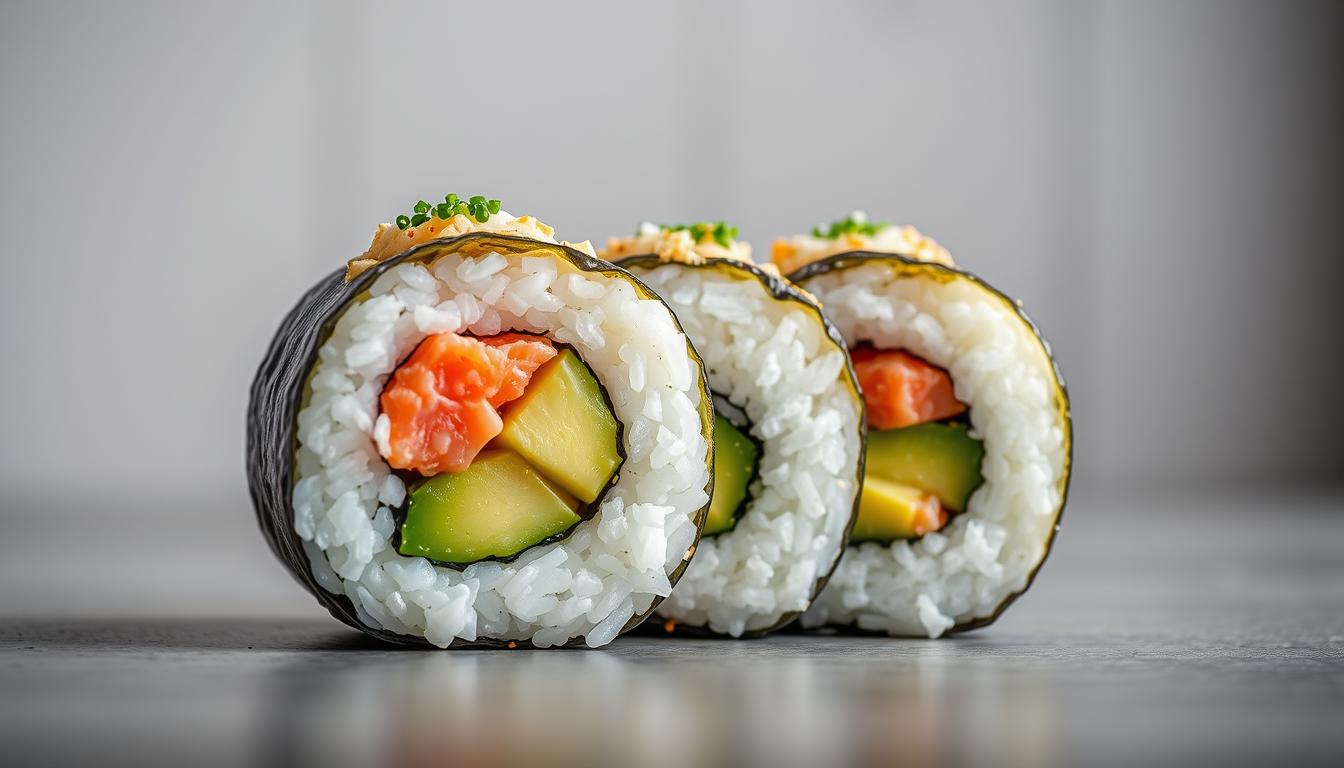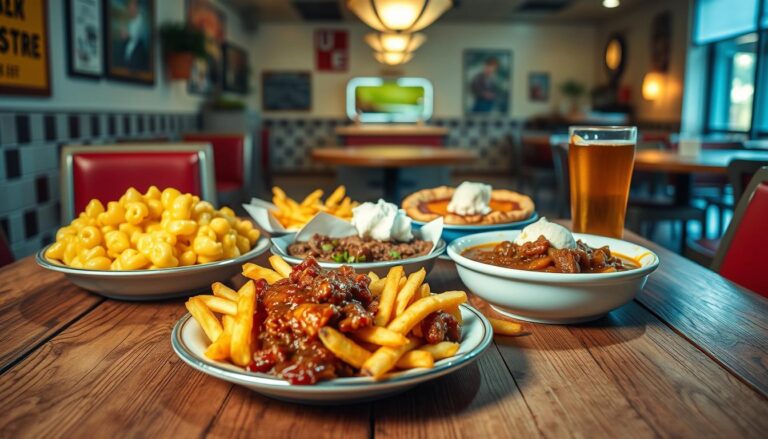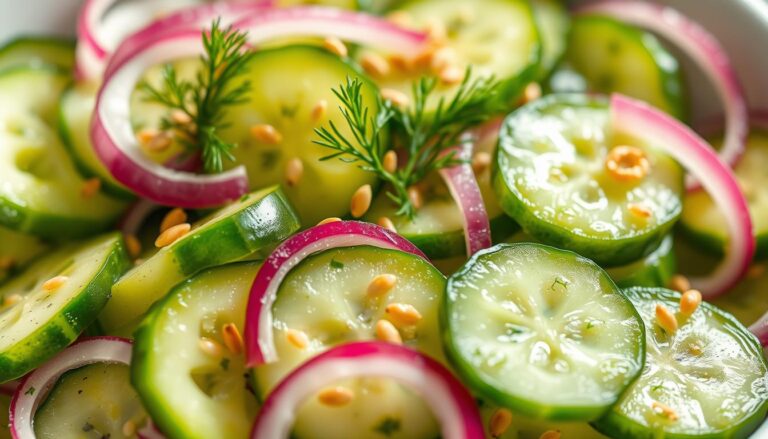Discover the Perfect California Roll Recipe
Making sushi at home can be a fun and rewarding experience, especially when you master the art of creating a delicious California roll. This popular dish, originating from Japanese cuisine, has become a staple in many sushi restaurants around the world.
With this simple sushi recipe, you can enjoy the taste of authentic Japanese cuisine in the comfort of your own home. The key to a perfect roll lies in the quality of the ingredients and the technique used to prepare it.
Key Takeaways
- Learn how to make a delicious California roll at home.
- Discover the essential ingredients for a perfect sushi recipe.
- Understand the importance of technique in preparing Japanese cuisine.
- Enjoy the taste of authentic sushi in the comfort of your own home.
- Improve your cooking skills with this simple and rewarding recipe.
The History and Origins of California Roll
The California roll, a staple in American sushi cuisine, has a fascinating history that spans decades. Its creation is attributed to the innovative chefs of Los Angeles in the 1960s, who sought to adapt traditional Japanese sushi to local tastes.
How the California Roll Revolutionized Sushi in America
The introduction of the California roll marked a significant turning point in the popularity of sushi across the United States. By using ingredients like imitation crab and avocado, it made sushi more accessible and appealing to the American palate. This inside-out roll became a sensation, paving the way for other innovative sushi creations.
The Story Behind Its Creation
The California roll is often credited to Ichiro Mashita, a sushi chef in Los Angeles, who experimented with local ingredients to create a unique sushi experience. The roll’s success was largely due to its innovative use of ingredients and its departure from traditional sushi-making techniques, making it a landmark in the evolution of sushi in America.
Essential Ingredients for an Authentic California Roll
Crafting an authentic California roll begins with selecting the finest sushi ingredients. The quality of these components directly impacts the taste, texture, and overall experience of your dish.
Selecting the Right Sushi Rice
The foundation of any great sushi is its rice. For a California roll, you’ll need short-grain Japanese rice, also known as sushi rice. This type of rice is stickier and clings together better than regular long-grain rice, making it ideal for rolling. When selecting sushi rice, look for freshness and check the packaging for any visible damage or moisture.
Choosing Quality Imitation Crab
Imitation crab, or surimi, is a crucial ingredient in traditional California rolls. It’s made from fish that’s been pulverized and reformed to mimic the texture of real crab. When choosing imitation crab, opt for brands that use sustainable fish sources and have minimal additives. Check the packaging for any signs of damage or freezer burn.
Fresh Avocado, Cucumber, and Nori
In addition to sushi rice and imitation crab, you’ll need fresh avocado, cucumber, and nori seaweed sheets to complete your California roll. Choose ripe avocados that are slightly soft to the touch, and select firm, fresh cucumbers. For nori, look for sheets that are crisp and have a deep green color. These ingredients come together to create the classic flavor profile of a California roll.
Tools and Equipment You’ll Need
Before you start rolling, let’s talk about the essential tools you’ll need for making California rolls. Having the right equipment can make a significant difference in your sushi-making experience.
Essential Sushi-Making Tools
To make sushi like a pro, you’ll need a few key tools. These include:
- Bamboo Rolling Mats: These mats are crucial for shaping and rolling your sushi evenly.
- Rice Paddles: A rice paddle helps you handle and mix your sushi rice without damaging the grains.
Bamboo Rolling Mats
Bamboo rolling mats, also known as sushi mats, are a must-have for creating uniform rolls. They help you apply the right amount of pressure to form compact, evenly sized rolls.
Rice Paddles and Sharp Knives
A good rice paddle is essential for mixing and handling sushi rice, while a sharp knife is necessary for cutting your rolls into clean, precise pieces.
Helpful but Optional Equipment
While not essential, some additional tools can enhance your sushi-making experience. These include:
- A sushi rice cooker for perfectly cooked rice
- A sharpener to keep your knives in top condition
Preparing the Perfect Sushi Rice
The secret to a delicious California roll begins with the preparation of its sushi rice. Sushi rice is more than just a side dish; it’s the foundation that holds the entire roll together. Preparing it correctly is crucial for achieving that authentic sushi taste.
Rice Selection and Washing Techniques
Selecting the right type of rice is the first step. Japanese short-grain rice is ideal for sushi due to its sticky texture. Rinsing the rice thoroughly before cooking is essential to remove excess starch, ensuring the rice doesn’t become too sticky or clumpy.
Cooking Methods for Ideal Texture
Cooking sushi rice requires attention to detail. The rice should be cooked in a ratio of 1:1 with water. Using a rice cooker can simplify this process, but it’s also possible on the stovetop with careful monitoring. The goal is to achieve a tender yet slightly firm texture.
Seasoning Your Rice with Vinegar Mixture
Once cooked, the rice needs to be seasoned with a mixture of rice vinegar, sugar, and salt. This step is crucial as it gives sushi rice its distinctive flavor. The seasoning should be done gently to avoid breaking the rice grains, and the rice should be allowed to cool to room temperature.
| Ingredient | Quantity |
|---|---|
| Rice Vinegar | 1/4 cup |
| Sugar | 1 tablespoon |
| Salt | 1 teaspoon |
By following these steps, you can achieve perfectly prepared sushi rice that’s ready to be turned into delicious California rolls.
The Perfect California Roll Recipe Step-by-Step
Now that we have covered the history and essential ingredients, it’s time to dive into the step-by-step guide for making the perfect California roll. This guide will walk you through ingredient measurements and preparation, assembling your California roll, and cutting and serving your finished rolls.
Ingredient Measurements and Preparation
To start, you’ll need to prepare your ingredients according to the measurements required for your recipe. For a standard California roll, you’ll typically need:
- 1 cup of prepared sushi rice
- 1/2 avocado, sliced
- 1/2 cucumber, sliced
- 1/2 cup of imitation crab meat
- 1 sheet of nori seaweed
Ensure that your sushi rice is cooked and seasoned with the appropriate vinegar mixture. Slice your avocado and cucumber into thin strips, and gently pat them dry with a paper towel to remove excess moisture.
Assembling Your California Roll
Assembling your California roll requires some finesse, but with practice, you’ll get the hang of it. Start by layering your ingredients on the nori sheet.
Layering Rice on Nori
Spread a thin, even layer of sushi rice onto your nori sheet, leaving about 1 inch of space at the top. Make sure to handle the rice gently to avoid applying too much pressure, which can cause the rice to become compacted.
Adding Fillings in the Right Order
Place your fillings – imitation crab, avocado, and cucumber – horizontally across the middle of the rice. The order of your fillings can affect the overall taste and texture of your roll, so feel free to experiment and find your preferred combination.
Cutting and Serving Your Finished Rolls
Once you’ve rolled your California roll, it’s time to slice it into individual pieces. Use a sharp knife, and gently saw back and forth to avoid applying too much pressure, which can cause the roll to tear. Serve your California rolls with soy sauce, wasabi, and pickled ginger for an authentic sushi experience.
Mastering the Inside-Out Rolling Technique
Mastering the inside-out rolling technique is crucial for creating authentic California rolls at home. This technique allows you to achieve that perfect balance of fillings and sushi rice, all wrapped in a delicate layer of nori seaweed. With practice and the right guidance, you’ll be rolling like a pro in no time.
Setting Up Your Workstation
Before you start rolling, it’s essential to set up your workstation correctly. Begin by placing a bamboo sushi mat on a flat surface, with the slats facing you. Ensure your ingredients are within easy reach, and have a small bowl of water handy to help with handling sticky rice.
- Position your bamboo sushi mat correctly
- Keep ingredients within easy reach
- Have a bowl of water nearby
Handling Sticky Rice Without Frustration
Handling sticky rice can be one of the most challenging aspects of making sushi. To minimize frustration, wet your hands with water before handling the rice, and use a gentle touch when applying the rice to the nori. This will help prevent the rice from sticking to your hands and ensure an even layer.
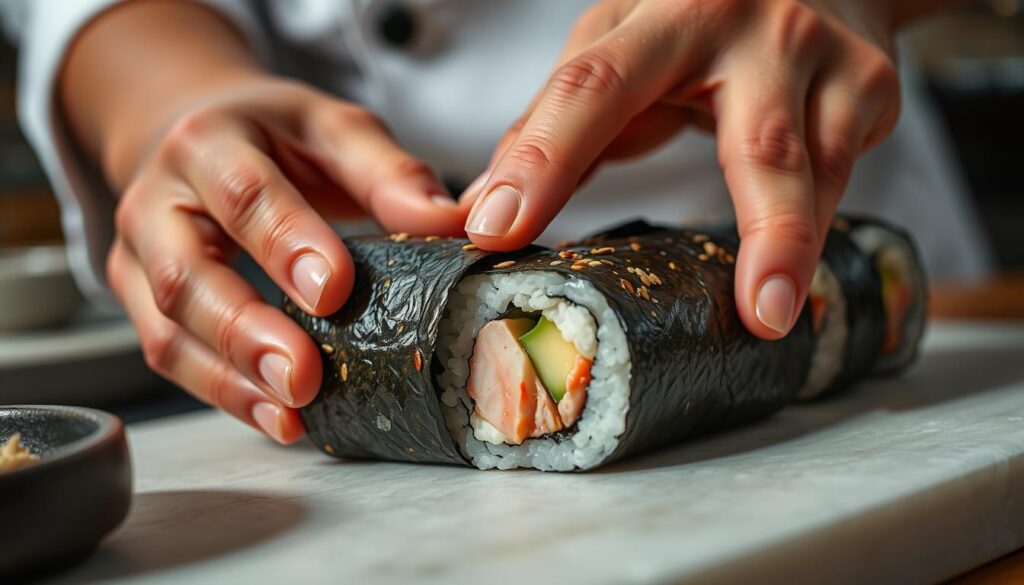
Troubleshooting Common Rolling Problems
Even experienced sushi makers encounter problems when rolling. Common issues include uneven rice distribution, nori tearing, and fillings spilling out. To overcome these challenges, ensure your ingredients are prepared correctly, and apply even pressure when rolling. If you encounter problems, don’t be discouraged – practice makes perfect.
Key troubleshooting tips:
- Check your ingredient preparation
- Apply even pressure when rolling
- Practice regularly to improve your skills
Creative California Roll Variations to Try at Home
Unleash your culinary creativity with unique California roll recipes that are simple to prepare. The classic California roll is a staple in many sushi restaurants, but its versatility allows for countless variations that can cater to different tastes and dietary preferences.
Spicy California Roll with Sriracha Mayo
Add a spicy kick to your California roll with sriracha mayonnaise. This variation combines the creaminess of mayonnaise with the heat of sriracha, complementing the crab and avocado perfectly. Simply mix sriracha into mayonnaise to your desired level of spiciness and spread it on your roll before adding other ingredients.
Vegetarian and Vegan California Roll Options
For vegetarians and vegans, the traditional imitation crab can be replaced with alternatives like tofu or tempeh. You can also add a variety of vegetables such as carrots, cucumbers, and asparagus to enhance flavor and texture. Using vegan mayonnaise or avocado as a substitute for cream cheese can also make the roll vegan-friendly.
Fusion-Inspired California Roll Creations
Experiment with fusion-inspired California rolls by incorporating non-traditional ingredients. For example, adding grilled chicken or steak can give your roll a protein boost. You can also try using different types of cheese or adding a layer of teriyaki sauce for a unique flavor profile. The key is to balance flavors while maintaining the integrity of the roll.
Delicious Sauces and Accompaniments
Enhance your California roll experience with a variety of delicious sauces and accompaniments. The right condiments can elevate the flavors and textures of your sushi, making each bite more enjoyable.
Traditional Soy Sauce, Wasabi, and Pickled Ginger
Traditional Japanese condiments play a crucial role in the sushi-eating experience. Soy sauce provides a salty, umami flavor, while wasabi adds a spicy kick. Pickled ginger, or gari, serves as a palate cleanser between bites. These classic accompaniments are essential for an authentic sushi experience.
Creative Dipping Sauces and Toppings
For those looking to mix things up, there are numerous creative dipping sauces and toppings to try. From spicy mayo to eel sauce, these additions can add depth and excitement to your California rolls.
Spicy Mayo and Eel Sauce
Spicy mayo combines the creaminess of mayonnaise with the heat of chili peppers or sriracha, adding a bold flavor to your sushi. Eel sauce, on the other hand, is a sweet and savory condiment made from soy sauce, sake, and sugar. Both are popular choices for dipping sushi.
Crunchy Toppings and Garnishes
Adding crunchy elements like toasted sesame seeds, chopped nuts, or crispy tempura bits can provide a satisfying texture contrast to your soft sushi rolls. These toppings not only add flavor but also enhance the visual appeal of your dish.
Presentation Tips for Restaurant-Quality California Rolls
Take your California rolls to the next level with these simple yet effective presentation techniques. A beautifully presented dish can elevate the dining experience and make your homemade sushi stand out.
Cutting Techniques for Clean, Even Pieces
To achieve clean, even cuts, use a sharp sushi knife. Cutting on a diagonal can make your rolls appear larger and more appealing. For uniform pieces, measure your cuts carefully, and consider using a ruler as a guide.
Chilling your rolls before cutting can also help maintain their shape and make them easier to slice.
Plating and Garnishing Ideas
When it comes to plating sushi, simplicity is key. A clean, minimalist plate allows the colors and textures of your California rolls to shine. Consider adding garnishes like thinly sliced daikon, shiso leaves, or toasted sesame seeds to add visual interest.
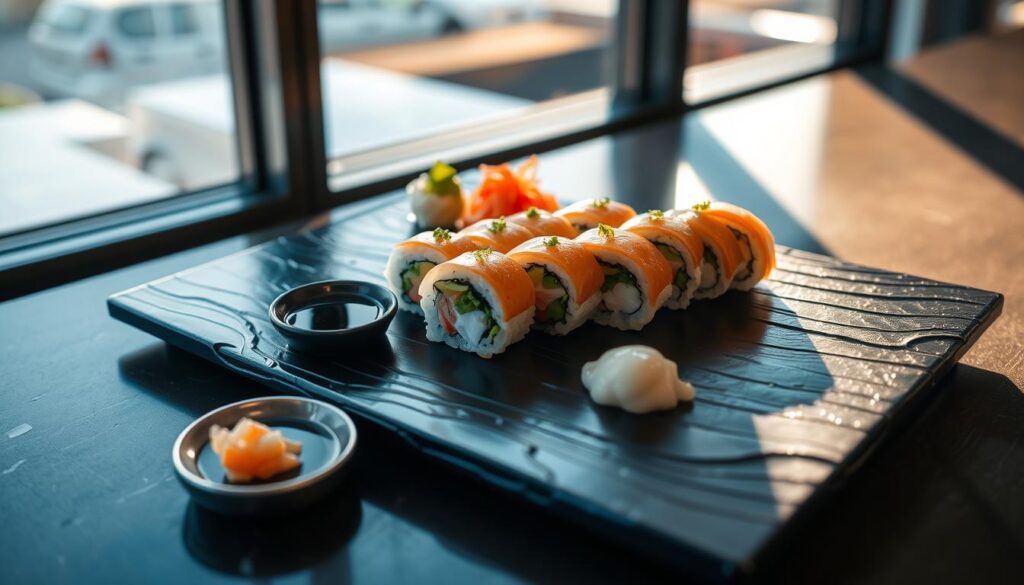
For an added touch, drizzle a small amount of soy sauce or your favorite dipping sauce artfully around the plate. The key to great sushi presentation is balance and restraint, so don’t overdo it with the garnishes.
Storing and Making California Rolls Ahead of Time
Mastering the art of storing California rolls is crucial for maintaining their freshness and flavor. Whether you’re preparing for a party or simply want to enjoy your favorite sushi at home, knowing how to store California rolls properly is essential.
Proper Storage Methods to Maintain Freshness
To keep your California rolls fresh, it’s vital to store them correctly. Wrap each roll tightly in plastic wrap or aluminum foil to prevent moisture from entering or escaping. You can then place the wrapped rolls in an airtight container or zip-top bag. For optimal freshness, store them in the refrigerator at a temperature below 40°F (4°C). When storing sushi, it’s also important to keep it away from strong-smelling foods, as sushi can absorb odors easily.
How Far in Advance Can You Prepare Components
While it’s best to assemble and consume California rolls on the same day, you can prepare certain components ahead of time. Sushi rice can be cooked and stored in the refrigerator for up to a day. Imitation crab, avocado, and cucumber can also be prepared in advance, but it’s recommended to assemble the rolls just before serving to maintain their texture and freshness. Making sushi ahead of time can be convenient, but be mindful of the ingredients’ limitations to ensure the best taste and quality.
Pairing Your California Roll with Drinks and Sides
The art of enjoying a California roll lies in the harmony between the roll, drinks, and accompanying dishes. To create a well-rounded sushi experience, it’s essential to consider both traditional Japanese beverages and modern options.
Traditional Japanese Beverages and Accompaniments
Traditional Japanese beverages such as green tea and sake are classic pairings for sushi. Green tea, with its subtle bitterness, complements the richness of the roll, while sake offers a more celebratory drinking experience. For sides, pickled ginger and wasabi are staples that cleanse the palate between bites.
| Beverage/Side | Description | Pairing Benefit |
|---|---|---|
| Green Tea | Subtle, slightly bitter tea | Complements roll richness |
| Sake | Traditional Japanese alcohol | Celebratory drinking experience |
| Pickled Ginger | Sweet and sour ginger | Cleanses the palate |
Modern Beverage and Side Dish Options
For those looking to innovate, modern beverage options like ramune or cucumber lime refresher can add a fun twist. Side dishes such as edamame or seaweed salad provide a refreshing contrast to the richness of the California roll.
As noted by sushi experts, “The key to a great sushi experience is balance.” Balancing traditional elements with modern twists can elevate your California roll experience.
Conclusion
With the right ingredients and techniques, you can create delicious California rolls in the comfort of your own home. By following the steps outlined in this article, you’ll be well on your way to mastering the art of sushi making.
Using quality ingredients, such as fresh avocado and imitation crab, is crucial to creating an authentic California roll. Practicing your sushi-making techniques, including preparing sushi rice and rolling your California rolls, will help you achieve professional results.
Now that you’ve learned the basics of California roll preparation, it’s time to get creative with your sushi recipe. Try experimenting with different fillings and toppings to make your California rolls truly unique. With practice and patience, you’ll become a skilled sushi maker, capable of impressing friends and family with your delicious California rolls.

